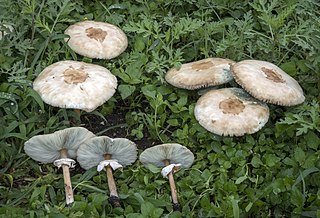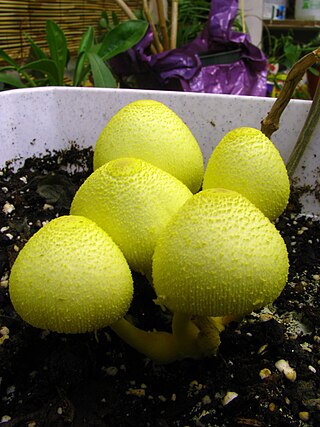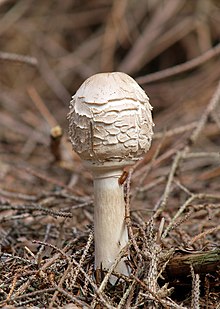
Secotioid fungi produce an intermediate fruiting body form that is between the mushroom-like hymenomycetes and the closed bag-shaped gasteromycetes, where an evolutionary process of gasteromycetation has started but not run to completion. Secotioid fungi may or may not have opening caps, but in any case they often lack the vertical geotropic orientation of the hymenophore needed to allow the spores to be dispersed by wind, and the basidiospores are not forcibly discharged or otherwise prevented from being dispersed —note—some mycologists do not consider a species to be secotioid unless it has lost ballistospory.

The spore print is the powdery deposit obtained by allowing spores of a fungal fruit body to fall onto a surface underneath. It is an important diagnostic character in most handbooks for identifying mushrooms. It shows the colour of the mushroom spores if viewed en masse.

Lepiota is a genus of gilled mushrooms in the family Agaricaceae. All Lepiota species are ground-dwelling saprotrophs with a preference for rich, calcareous soils. Basidiocarps are agaricoid with whitish spores, typically with scaly caps and a ring on the stipe. Around 400 species of Lepiota are currently recognized worldwide. Many species are poisonous, some lethally so.

The Agaricaceae are a family of basidiomycete fungi and include the genus Agaricus, as well as basidiomycetes previously classified in the families Tulostomataceae, Lepiotaceae, and Lycoperdaceae.

Shaggy parasol is the common name for three closely related species of mushroom, Chlorophyllum rhacodes, C. olivieri and C. brunneum, found in North America, Europe and Southern Africa. C. brunneum is also found in Australia.

An annulus is the ring-like or collar-like structure sometimes found on the stipe of some species of mushrooms. The annulus represents the remnants of the partial veil, after it has ruptured to expose the gills or other spore-producing surface. It can also be called a ring which is what the Latin word annulus directly translates as. The modern usage of the Latin word originates from the early days of botany and mycology when species descriptions were only written in Latin. Outside of the formal setting of scientific publications which still have a Latin requirement, it will often just be referred to as a ring or stem ring in field guides and on identification websites.

Coprinus comatus, commonly known as the shaggy ink cap, lawyer's wig, or shaggy mane, is a common fungus often seen growing on lawns, along gravel roads and waste areas. The young fruit bodies first appear as white cylinders emerging from the ground, then the bell-shaped caps open out. The caps are white, and covered with scales—this is the origin of the common names of the fungus. The gills beneath the cap are white, then pink, then turn black and deliquesce ('melt') into a black liquid filled with spores. This mushroom is unusual because it will turn black and dissolve itself in a matter of hours after being picked or depositing spores.

Macrolepiota procera, the parasol mushroom, is a basidiomycete fungus with a large, prominent fruiting body resembling a parasol. It is a fairly common species on well-drained soils. It is found solitary or in groups and fairy rings in pastures and occasionally in woodland. It is widespread in temperate regions of Eurasia and possibly North America. Further research is needed to confirm whether specimens found in North America are the same species.

Chlorophyllum molybdites, commonly known as the green-spored parasol, false parasol, green-spored lepiota and vomiter, is a widespread mushroom. Poisonous and producing severe gastrointestinal symptoms of vomiting and diarrhea, it is commonly confused with the shaggy parasol or shaggy mane, and is the most commonly misidentified poisonous mushroom in North America. Its large size and similarity to the edible parasol mushroom, as well as its habit of growing in areas near human habitation, are reasons cited for this. The nature of the poisoning is predominantly gastrointestinal.

Macrolepiota is a genus of white spored, gilled mushrooms of the family Agaricaceae. The best-known member is the parasol mushroom (M. procera). The widespread genus contains about 40 species.

Leucocoprinus is a genus of fungi in the family Agaricaceae. Its best-known member is the distinctive yellow mushroom Leucocoprinus birnbaumii, which is found in plant pots and greenhouses worldwide. The type species is Leucocoprinus cepistipes. The genus has a widespread distribution and contains over 80 recognised species, however many of these species are very scarcely recorded and little known with only a small number of Leucocoprinus species which are commonly observed. The majority of the species in this genus are exclusive to tropical environments however numerous species have become a common sight in plant pots and greenhouses resulting in them becoming well known worldwide.

Macrolepiota clelandii, commonly known as the slender parasol or graceful parasol, is a species of mushroom-forming fungus in the family Agaricaceae. The species is found in Australia and New Zealand, where it fruits singly or in small groups on the ground in eucalypt woodlands, parks, and roadsides. It is a tall mushroom up to roughly 20 cm (8 in), with a broad cap covered with distinctive rings of dark brown scales. The whitish gills on the cap underside are closely spaced and free from attachment to the slender stipe, which has a loose ring on its upper half, and a bulbous base. The edibility of the mushroom is not known with certainty, but closely related parasol mushrooms are edible and some are very sought after.

Macrolepiota excoriata is a mushroom in the family Agaricaceae.
Chlorolepiota is a genus of fungi in the family Agaricaceae. It is characterized by mushrooms with a macrolepiotoid habit, a pruinose yellow-greenish spore print, and the lack of clamp connections in the hyphae. The genus was circumscribed in 1979, with C. mahabaleshwarensis as the type and only species. C. indica was described in 2013, and C. brunneotincta in 2014. All species are found in India. The generic name Chlorolepiota is a portmanteau of Chlorophyllum and Macrolepiota, two closely related genera.

Leucoagaricus americanus, commonly known as the American parasol, is a mushroom in the genus Leucoagaricus, native to North America. It was first described by Charles Horton Peck, an American mycologist of the 19th and early 20th centuries, in 1869. It is widely distributed in North America, though more common east of the Rocky Mountains; it is saprobic, and grows on sawdust, on wood chips, on stumps, and on the ground.

Lepiota cristata, commonly known as the stinking dapperling, brown-eyed parasol, or the stinking parasol, is an agaric and possibly poisonous mushroom in the family Agaricaceae. A common and widespread species—one of the most widespread fungi in the genus Lepiota—it has been reported from Europe, northern Asia, North America, and New Zealand. It fruits on the ground in disturbed areas, such as lawns, path and road edges, parks, and gardens. The species produces fruit bodies characterized by the flat, reddish-brown concentric scales on the caps, and an unpleasant odour resembling burnt rubber. Similar Lepiota species can sometimes be distinguished from L. cristata by differences in cap colour, stipe structure, or odour, although some species can only be reliably distinguished through the use of microscopy.

Macrolepiota mastoidea is a species of mushroom producing fungus in the family Agaricaceae.

Chlorophyllum agaricoides, commonly known as the gasteroid lepiota, puffball parasol, false puffball, or puffball agaric, is a species of fungus belonging to the family Agaricaceae. When young, it is edible, and has been traditionally eaten in Turkey for many years.

Macrolepiota zeyheri is a species of mushroom producing fungus in the family Agaricaceae. In the Kilendu dialect it is known as djilo and in the Kilur dialect it is called n'volo mighom.
Leucocoprinus gandour is a species of mushroom-producing fungus in the family Agaricaceae.





















